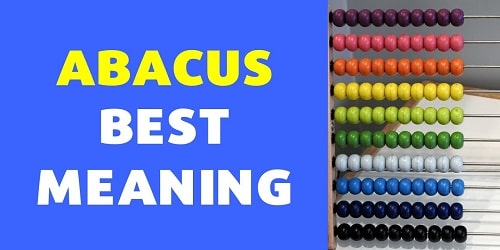Abacus Meaning
It is possible that the word abacus arose from the Greek term “ábax” and the Latin “abacus” used to name a table or a table for making accounts, since in ancient times, stones or seeds that were used as calculation instruments They were attached to rods. Already at the dawn of ancient times, Mesopotamian peoples used abacuses to count. Its use in Europe was widespread in the Middle Ages and gradually it was put aside until it almost disappeared in the 18th century. Electronic calculators contributed to its eradication in everyday practice. Its use is still common in Asia.
In this way, today we call an abacus a simple instrument used to make accounts, especially used in children who begin to carry out their first mathematical operations. They are also known as accountants. It is composed of a square originally made of wood, but which can currently be found in other materials, which supports ten thin, parallel rods, on which ten balls with holes in their center are placed in each one, which can move on the rods and thus be able to do relatively simple calculations, such as addition, subtraction, multiplication, and division.
The Napier abacus was described by its inventor, the Scottish mathematician, and the first expositor of logarithms, John Napier in 1617. His method consisted of reducing multiplications to additions and divisions to subtractions. The boxes were 9, each located with its number on the left side, representing the multiplicands. Another row at the top indicates the multipliers. The rest of the boxes are divided by a diagonal line, where a number that can be 0 is placed at the top, in which case it is not read, and another number at the bottom. If the number at the top of the diagonal line is not zero, integrate the product of the multiplication of the left square and the top square.
In Geography, we find the Abaco Islands to the north of the Bahamas, of great tourist importance. The largest are two: The Great Abaco and the Little Abaco.
Abacus Meaning in Hindi
यह संभव है कि अबेकस शब्द ग्रीक शब्द “अबेक्स(Abacus )” और लैटिन शब्द “अबैकस” से उत्पन्न हुआ हो, जिसका उपयोग खाते बनाने के लिए एक तालिका या तालिका का नाम देने के लिए किया जाता था, क्योंकि प्राचीन काल में, पत्थर या बीज जिन्हें गणना उपकरणों के रूप में उपयोग किया जाता था, उन्हें छड़ से जोड़ा जाता था। प्राचीन काल की शुरुआत में ही, मेसोपोटामिया के लोग गिनती करने के लिए अबेकस का इस्तेमाल करते थे। यूरोप में इसका उपयोग मध्य युग में व्यापक था और धीरे-धीरे इसे अलग रखा गया जब तक कि यह 18वीं शताब्दी में लगभग गायब नहीं हो गया। इलेक्ट्रॉनिक कैलकुलेटर ने रोजमर्रा के व्यवहार में इसके उन्मूलन में योगदान दिया। इसका उपयोग अभी भी एशिया में आम है।
इस तरह, आज हम अबेकस को खाते बनाने के लिए इस्तेमाल किया जाने वाला एक सरल उपकरण कहते हैं, खासकर उन बच्चों में इस्तेमाल किया जाता है जो अपना पहला गणितीय संचालन करना शुरू करते हैं। उन्हें अकाउंटेंट के रूप में भी जाना जाता है। यह मूल रूप से लकड़ी से बने एक वर्ग से बना है, लेकिन जो वर्तमान में अन्य सामग्रियों में पाया जा सकता है, जो दस पतली, समानांतर छड़ों को सहारा देता है, जिन पर उनके केंद्र में छेद वाली दस गेंदें रखी जाती हैं, जो छड़ों पर घूम सकती हैं और इस प्रकार अपेक्षाकृत सरल गणनाएँ करने में सक्षम होती हैं, जैसे जोड़, घटाव, गुणा और भाग।
नेपियर एबेकस का वर्णन इसके आविष्कारक, स्कॉटिश गणितज्ञ, लघुगणक के पहले व्याख्याता, जॉन नेपियर ने 1617 में किया था। उनकी विधि में गुणन को जोड़ और भाग को घटाव में कम करना शामिल था। बक्से 9 थे, प्रत्येक बाईं ओर अपनी संख्या के साथ स्थित था, जो गुणकों का प्रतिनिधित्व करता था। शीर्ष पर एक और पंक्ति गुणकों को इंगित करती है। शेष बक्से एक विकर्ण रेखा से विभाजित होते हैं, जहां एक संख्या जो 0 हो सकती है उसे शीर्ष पर रखा जाता है, जिस स्थिति में इसे पढ़ा नहीं जाता है, और नीचे एक और संख्या होती है। यदि विकर्ण रेखा के शीर्ष पर संख्या शून्य नहीं है, तो बाएं वर्ग और शीर्ष वर्ग के गुणन के गुणनफल को एकीकृत करें।
भूगोल में, हम बहामास के उत्तर में अबाको द्वीप पाते हैं, जो पर्यटकों के लिए बहुत महत्वपूर्ण है। इनमें से दो सबसे बड़े हैं: ग्रेट अबाको और लिटिल अबाको।

